
Picking the best bedding isn't just about aesthetics; it's about comfort and functionality. Did you know that the material of your bedding can significantly affect your sleep quality? For instance, cotton is a popular choice because it's breathable and soft, but have you ever considered bamboo? Bamboo sheets are not just eco-friendly—they're also hypoallergenic and perfect for hot sleepers because they wick away moisture. So if you often find yourself kicking off the covers at night, bamboo might be worth a try.
Speaking of staying cool, let's talk about thread count. Many people think higher thread counts always mean better quality. That's not entirely true. A 400-thread count made of long-fiber cotton can feel much better than a 1000-thread count of lower-quality material. It's essential to look beyond the numbers. Instead, feel the fabric, check the fibers, and make sure it aligns with your personal comfort needs.
Understanding Materials
When it comes to choosing the best bedding, understanding the materials is a great starting point. Different materials suit different needs, so knowing what they offer could make all the difference in your comfort.
Cotton
Let's start with cotton. It's probably the most popular choice for bedding because it's breathable, durable, and soft. If you have sensitive skin, you'd like Egyptian cotton for its long fibers that make the fabric smoother and more durable. However, your standard cotton blend sheets are still a solid, affordable choice.
Linen
If you're someone who runs hot at night, linen could be your new best friend. This material is superb for its breathability and ability to wick moisture, which is perfect for sweaty sleepers. Plus, it naturally has a rustic, relaxed look, which can add a bit of charm to your bedroom.
Bamboo
Bamboo sheets are gaining in popularity because they are eco-friendly and hypoallergenic. They have a unique softness and are cooler to the touch, which is excellent for those warm nights. Besides, bamboo mattress covers can help keep you cool.
Silk
Silk sheets are a luxury that feels as good as they look. They are naturally hypoallergenic and great for both skin and hair. If you're after that silky smooth feel, silk is worth the investment, though they do require a bit more care in washing and maintenance.
In case you're curious about how these materials stack up:
| Material | Breathability | Durability | Care |
|---|---|---|---|
| Cotton | Highly breathable | Very durable | Easy to care |
| Linen | Extremely breathable | Incredibly durable | Gets softer with wash |
| Bamboo | Very breathable | Durable | Needs gentle care |
| Silk | Moderately breathable | Less durable | Requires careful maintenance |
Consider what matters most to you and weigh the pros and cons of each material. Do you prioritize breathability or durability? In the end, the best choice is what makes you sigh in comfort at night.
Thread Count Myths
Let's get real about thread count. You've probably heard that the higher the thread count, the better the sheet, right? Well, that's not always the case. Sure, a higher thread count can mean better quality, but it can also be a marketing gimmick. Anything above 800 is suspect and often created by twisting together lower-quality fibers to inflate the count.
Why Thread Count Isn't Everything
Quality over quantity really applies here. The type of fiber is just as crucial as the count itself. Look for sheets made from high-quality cotton, like Egyptian or Pima cotton. These materials breathe well and feel soft. The weave also plays a role; a percale weave offers a cool, crisp feel, while sateen has a smoother, more luxurious texture.
What's the Sweet Spot?
If you're shopping for bedding, a thread count between 300 and 500 will usually provide the perfect blend of softness and durability. Anything more is often unnecessary. Remember, you're buying sheets to sleep on, not to impress anyone with a number!
Comparing Cotton To Other Materials
Cotton isn't your only option for bedding. Fabrics like linen have a naturally lower thread count but are highly breathable and perfect for warmer climates. Meanwhile, microfiber sheets are often less expensive and can offer a comfortable, cozy feel, especially in cooler months.
Fact Check: Thread Count and Durability
| Thread Count Range | Durability | Softness |
|---|---|---|
| 200-300 | Moderate | Crisp |
| 300-500 | Good | Soft |
| 500-800 | High | Very Soft |
| 800+ | Varies | Marketing Hype |
So, when you're out there searching for the best bedding, don't be fooled by the numbers. Feel the fabric, consider your preferences, and think about what will work best for you. Your comfort is the top priority!

Choosing for Seasons
When it comes to bedding, matching your choices with the seasons isn't just a decorative move—it's a way to enhance your comfort throughout the year. Let's break down the key options for each season, so you can sleep easy and cozy.
Spring and Summer
In the hot months, your priority should be about breathability and moisture-wicking materials. Consider bedding made from cotton or bamboo. Both materials are known for their natural cooling properties and help in wicking moisture away, keeping you sweat-free. If you're willing to splurge a little, linen is another fantastic option—it’s lightweight and has natural temperature-regulating qualities.
- Tip: Stick to lighter colors like white or pastel shades—they reflect heat better, keeping your sleeping environment cooler.
Fall and Winter
Once the temperature drops, you’ll want bedding that adds warmth without making you feel suffocated. This is where materials like flannel and wool come into play. Flannel sheets are cozy and give you that warm snuggle-up feel. Wool, on the other hand, offers excellent insulation and is naturally breathable, so it lets your body breathe while keeping you warm.
- Tip: Consider layering with a comforter or duvet for that adjustable warmth. That way, if you get too hot, you can easily peel back a layer and find your perfect sleep temperature.
If you love keeping track of your bedding inventory each season, this little data snippet might be relevant for you:
| Material | Season | Properties |
|---|---|---|
| Cotton | Spring/Summer | Breathable, Moisture-Wicking |
| Bamboo | Spring/Summer | Eco-Friendly, Cooling |
| Flannel | Fall/Winter | Warm, Cozy |
| Wool | Fall/Winter | Insulating, Breathable |
By tailoring your bedding to the seasons, you're optimizing each night's sleep quality. Just remember, the key is comfort and practicality based on what each season demands. That way, whether it's a chilly winter night or a sizzling summer evening, your bedding has got your back!
Maintenance Tips
Keeping your bedding in top condition extends its life and ensures you get the most out of that investment. And yes, it can directly affect how well you sleep. So, let's break down how to take care of your bedding to ensure it's always as fresh as possible.
Washing Best Practices
First off, make sure you follow the care label instructions. Not all materials are treated the same. Cotton bedding usually does well with warm water, but delicate materials like silk might need something gentler, like cold water and a delicate cycle.
For most sheets, it’s a good idea to wash them every one to two weeks. This might sound frequent, but think about how much time you spend with them every night!
The Drying Game
When it comes to drying, air-drying is ideal, especially for delicate items. If you're using a dryer, keep the heat low to avoid shrinking. Toss in some dryer balls to keep things soft and reduce wrinkles.
Avoid over-drying as it can weaken fibers over time. Take them out when they're still slightly damp to make fabric feel softer and reduce wrinkles.
Storage Solutions
Once your sheets are clean, store them in a cool, dry place. Consider using breathable fabric containers or cotton bags rather than plastic to prevent mold.
Keep a rotation of bedding sets, so you're not wearing out your favorite pair too quickly. This also means you always have something fresh on hand, reducing that laundry panic.
Quick Fixes for Stains
If you spill something on your bedding, don’t panic! A mix of cold water and gentle detergent usually does the trick. Dab (don’t scrub) the stain to prevent it from setting.
| Material | Washing Temp | Drying Recommendation |
|---|---|---|
| Cotton | Warm | Tumble dry low |
| Silk | Cold | Air dry |
| Bamboo | Cold | Tumble dry low |
By keeping these maintenance tips in mind, not only do you prolong the life of your bedding, but you also maximize comfort, making each night's sleep as inviting as possible.




